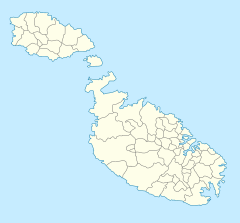Parliament House (Malta)
| Parliament House | |
|---|---|
| Il-Parlament il-Ġdid | |

View of the Parliament House
|
|
|
Location within Malta
|
|
| Alternative names | New Parliament Building |
| General information | |
| Status | Complete |
| Type | Legislative building |
| Town or city | Valletta |
| Country | Malta |
| Coordinates | 35°53′46.3″N 14°30′35.1″E / 35.896194°N 14.509750°E |
| Construction started | 2011 |
| Inaugurated | 4 May 2015 |
| Cost | €90 million |
| Client | Grand Harbour Regeneration Corporation |
| Owner | Government of Malta |
| Technical details | |
| Material | Limestone, concrete and steel |
| Floor count | 3 |
| Floor area | 23,000 m2 (250,000 sq ft) |
| Design and construction | |
| Architect | Renzo Piano |
| Architecture firm | Renzo Piano Building Workshop |
The Parliament House (Maltese: Il-Parlament il-Ġdid, meaning "The New Parliament") is the meeting place of the Parliament of Malta located in Valletta, Malta. The building was constructed between 2011 and 2015 to designs by Renzo Piano as part of the City Gate Project, which also included building a new City Gate and converting the ruins of the Royal Opera House into an open-air theatre. Construction of the Parliament House generated considerable controversy, mainly due to the modern design of the building and the cost of construction, which amounted to around €90 million.
From 1921 to 1976, the meeting place of the Parliament of Malta had been the Tapestry Chamber of the Grandmaster's Palace, also in Valletta. In 1976, the former armoury of the same palace was converted into a new parliament, and meetings were held there until the opening of the purpose-built Parliament House on 4 May 2015.
Parliament House is located in Republic Street near City Gate, the entrance to Valletta. The building is located adjacent to Saint James Cavalier and the ruins of the Royal Opera House, and opposite the City Gate Shopping Arcade and Palazzo Ferreria.
The site presently occupied by the Parliament House was originally built up with houses, and later the Valletta Station of the Malta Railway. The area was bombarded during World War II, and the station and surrounding buildings were demolished in the 1960s as part of a project to redevelop the entrance to Valletta. The area was converted into an open space known as Freedom Square (Maltese: Misraħ il-Ħelsien), which was surrounded by a shopping arcade. The square was rather plain, and was commonly used as a car park.
...
Wikipedia

